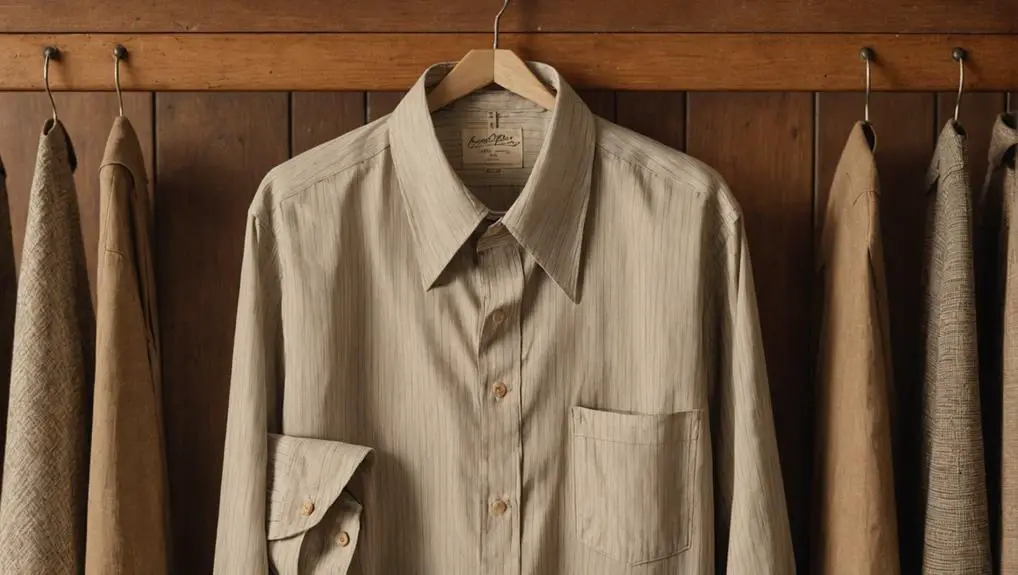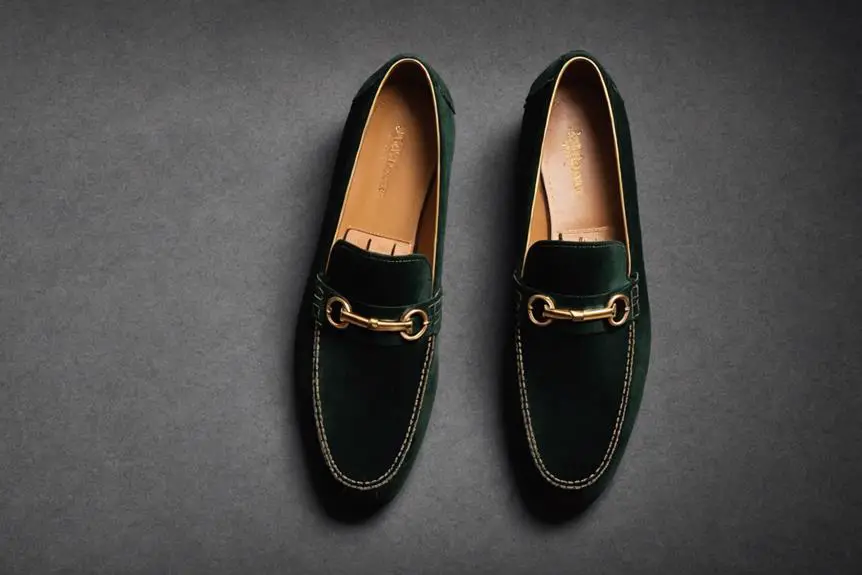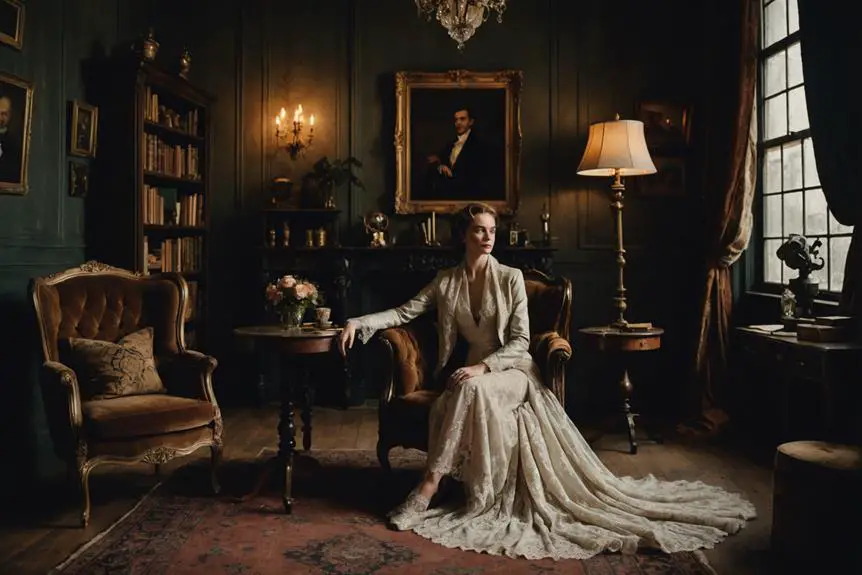Men's dress shirts in the 1940s reflected a fascinating blend of practicality and style, influenced by wartime fabric rationing and evolving social norms. You'd see spearpoint collars taking center stage, alongside tailored fits that emphasized a cleaner silhouette compared to the previous decade's bagginess. Vibrant colors like teal and peach gradually evolved to softer pastels, while patterns such as stripes and checks added visual interest. French cuffs became a standard in formal attire, showcasing craftsmanship. This era marked a shift toward comfort without sacrificing elegance. There's much more to uncover about the stylistic and cultural influences of this pivotal decade.
Overview of 1940s Shirt Styles
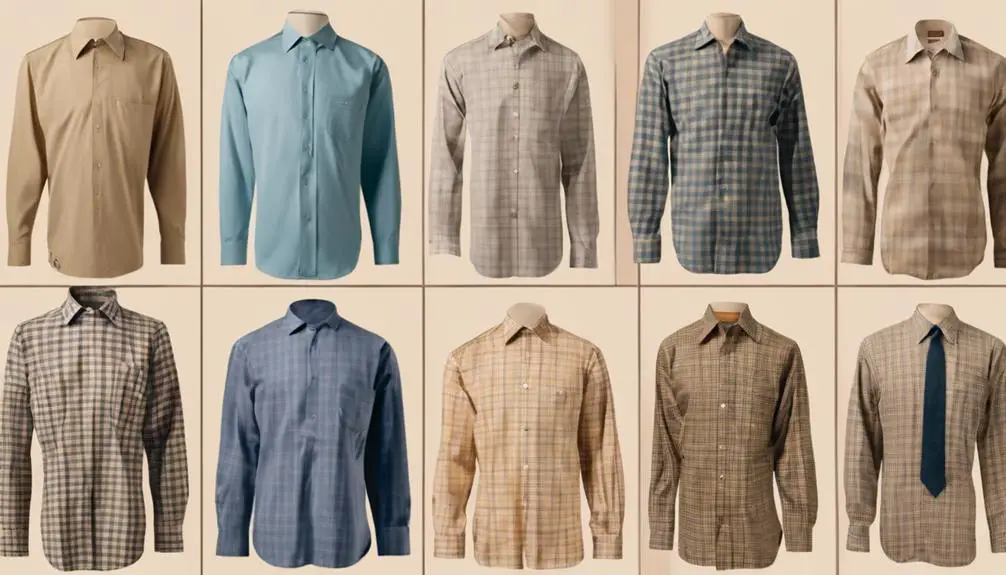
In the 1940s, men's dress shirts evolved considerably, reflecting both societal changes and shifting fashion sensibilities. The era showcased a variety of collar styles, with spearpoint collars gaining popularity for their sharp, elongated design that added sophistication to a man's look. While detachable and collarless options also existed, the spearpoint became a staple in vintage fashion, aligning with the decade's trend of refinement. This period also marked an increase in the use of high-quality fabrics and tailored craftsmanship, which are key characteristics of vintage clothing labels. As the decade progressed, the fit of shirts transformed from baggy to more tailored silhouettes, accommodating the structured suits of the time. This change emphasized torso shaping, making men appear more polished and modern. French cuffs became a standard feature in business shirts, elevating formal attire by allowing for the use of elegant cufflinks, while casual shirts often sported one or two chest pockets for a more relaxed appeal.
Color Trends in Men's Shirts
The evolution of men's dress shirts in the 1940s wasn't just about style; color played a significant role in defining the decade's aesthetic. Early in the decade, you'd find vibrant gemstone shades like teal blue-green, grey, white, blue, and peach dominating the scene. These colors reflected a boldness that echoed the resilience of the time, offering a vintage flair that was both striking and memorable.
As the mid-1940s arrived, a shift occurred toward softer pastels and muted tones. Light blue, tan, green, and grey became increasingly popular, suggesting a more subdued approach to fashion that mirrored the changing social landscape. Post-1948, "mellow" colors such as pink, peach, sky blue, and sage green began to emerge, emphasizing comfort and ease in men's shirts.
Throughout the decade, patterns like stripes, checks, plaid, and small dots provided an additional layer of visual interest, enhancing the overall appeal of these shirts. By the late 1940s, the palette brightened again, moving back to more saturated colors, showcasing how men's dress shirts evolved in tandem with the cultural shifts of the era.
Fit and Design Evolution
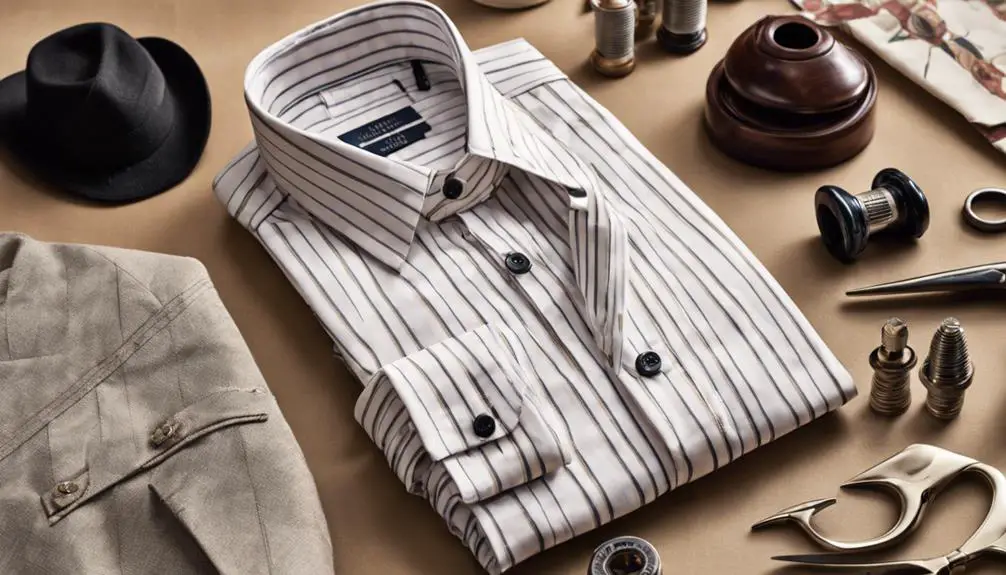
Shifting from the baggy silhouettes of the early 1940s, men's dress shirts began embracing a more fitted design that mirrored the changing demands of fashion and practicality. By the mid-1940s, you'd notice a distinct reduction in bulk under suits, as shirts evolved towards a more tailored fit that enhanced your overall appearance. This change wasn't just about comfort; it also reflected a broader movement in men's fashion that prioritized structure.
As the decade progressed, common styles featured single cuffs with buttons or French cuffs adorned with cuff links, emphasizing the shift towards refined design. The introduction of torso shaping brought a significant evolution in fit, creating a cleaner and more structured look that appealed to the modern man.
Popular Shirt Features
Men's dress shirts of the 1940s showcased a fascinating array of features that defined the era's style. One standout element was the variety of collar styles. Spearpoint collars, with their sharp, pointed edges, became a fashionable choice, offering a sleek look that paired well with the decade's tailored fits. Detachable collars also made a statement, allowing wearers to easily switch styles, while collarless options provided a more casual alternative.
The materials used were equally important, with cotton being the most popular choice due to its breathability and comfort. Wool gabardine and sanforized fabrics also gained traction, providing durability and unique textures.
Patterns played a significant role in the visual appeal of these shirts. Plaid, stripes, and solid colors, including salt & pepper and fine checks, dominated the scene, catering to diverse tastes.
Additionally, special features like barrel cuffs and tab collars enhanced the shirts' uniqueness. Military stenciling added a touch of character, reflecting the era's cultural context. Overall, these popular shirt features not only shaped individual style but also defined the broader fashion landscape of the 1940s.
Historical Influences on Fashion
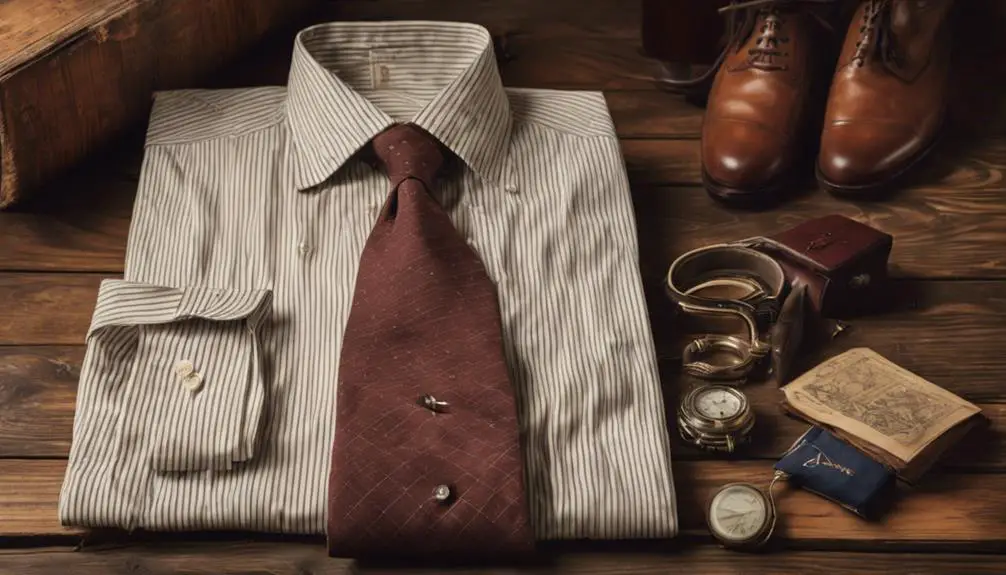
Fashion in the 1940s reflects a complex interplay of historical events that shaped its trajectory. The impact of World War II was profound, as fabric rationing led to a shift towards more utilitarian designs. You'll notice that the Dress Shirt Regular Fit became a staple, prioritizing comfort and practicality over extravagance. With material shortages, the era embraced Vintage Retro All Cotton fabrics, offering durability while maintaining a classic look.
Social changes during the war spurred a newfound sense of freedom and patriotism, which influenced casual styles in men's fashion. The introduction of laws limiting clothing purchases pushed designers to abandon aristocratic influences, creating accessible and functional garments. You can see this evolution in the military aesthetics that permeated men's dress shirts, particularly with the spear point collar gaining popularity.
As waistcoats fell out of favor, soft collars and long collar tips became commonplace, reflecting the changing norms of office attire. Additionally, the emergence of casual shirts, like camp style and Hawaiian shirts, illustrated a broader cultural shift, blending comfort with style. The 1940s established a foundation for contemporary fashion, driven by necessity and social transformation.
Notable Shirt Brands
Notably, several shirt brands have emerged that capture the essence of 1940s style, expertly blending vintage aesthetics with modern craftsmanship. Each of these brands brings something unique to the table, allowing you to embrace that classic vibe while enjoying contemporary quality.
- Spearpoint Revival: Renowned for its spearpoint collar shirts, this brand embodies the elegance and sophistication of the 1940s, offering a refined look for today's discerning man.
- Alimens & Gentle: Specializing in French cuff dress shirts complete with cufflinks, Alimens & Gentle echoes the formal dress standards of the era, ensuring you'll make a statement at any event.
- Revival Authentic: With its sand track stripe shirts, this brand captures the unique patterns that defined the decade, combining nostalgia with modern flair.
- Wrangler Authentics: Known for producing long sleeve classic woven shirts, Wrangler pays homage to the durable and practical styles that dominated men's fashion in the '40s.
These brands not only celebrate the past but also allow you to incorporate timeless elegance into your wardrobe today.
Pricing and Availability
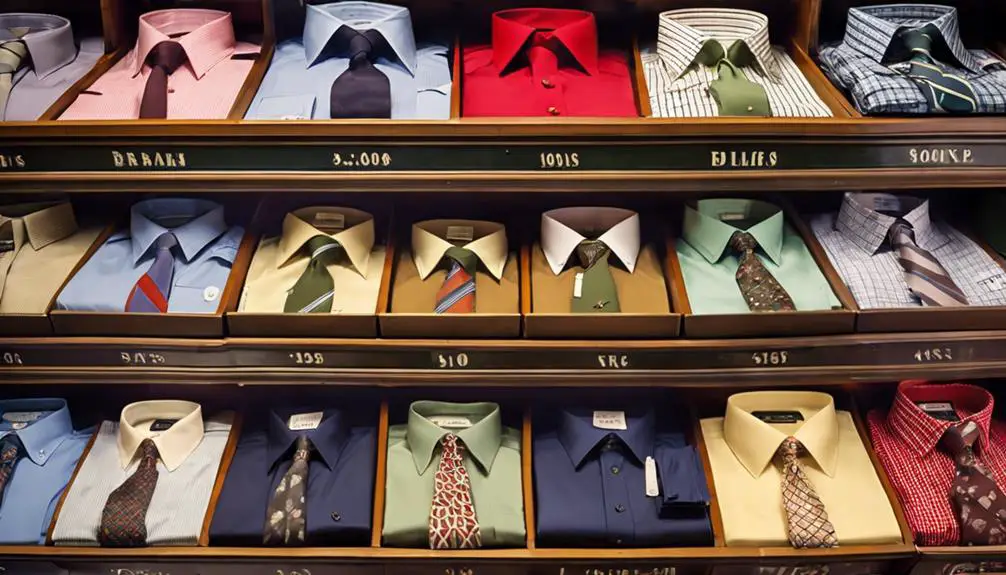
Exploring the pricing and availability of 1940s men's dress shirts reveals a diverse market, where vintage pieces can fetch prices from $32.99 to an eye-popping $999.99 based on their condition and rarity. If you're particularly interested in spearpoint collar shirts or French cuff dress shirts, you'll find that prices can vary considerably.
Here's a quick breakdown for your reference:
| Shirt Type | Price Range |
|---|---|
| Vintage Style Green Shirts | $32.99 – $999.99 |
| Spearpoint Collar Shirts | $57.66 – $420.00 |
| French Cuff Dress Shirts | ~$200.32 |
| Casual Blue Cotton Shirts | ~$19.99 |
| Shipping Options | Free/Varied |
Many listings also feature negotiation options, inviting you to make your best offer on these vintage treasures. This flexibility enhances your purchasing experience, allowing you to score a fantastic deal. Additionally, shipping costs can play a vital role in your decision-making process, as numerous sellers offer free shipping, making it easier to buy those sought-after shirts without breaking the bank.
Styling Casual 1940s Looks
The essence of 1940s casual style lies in its ability to combine comfort with a distinct sense of nostalgia. To achieve this look, start with a snug-fitting ringer T-shirt, often adorned with horizontal stripes that echo the era's playful spirit. Pair it with high-waisted, wide-leg trousers, which create a silhouette that feels both relaxed and structured—a hallmark of mens style during this time.
For footwear, consider classic options that emphasize both comfort and style:
- Loafers that add a touch of sophistication
- Lace-up oxfords for a polished finish
- Saddle shoes that inject a playful vibe
- Fisherman sandals for a breezy, laid-back feel
Layering is essential. A short sweater or cardigan over a dress shirt can elevate your outfit, giving it a semi-casual appearance suitable for various occasions. This versatility underscores the practicality of 1940s menswear. By thoughtfully combining these elements, you'll not only embrace the rich heritage of the time but also enjoy a look that remains relevant and stylish today.
Impact of World War II on Fashion
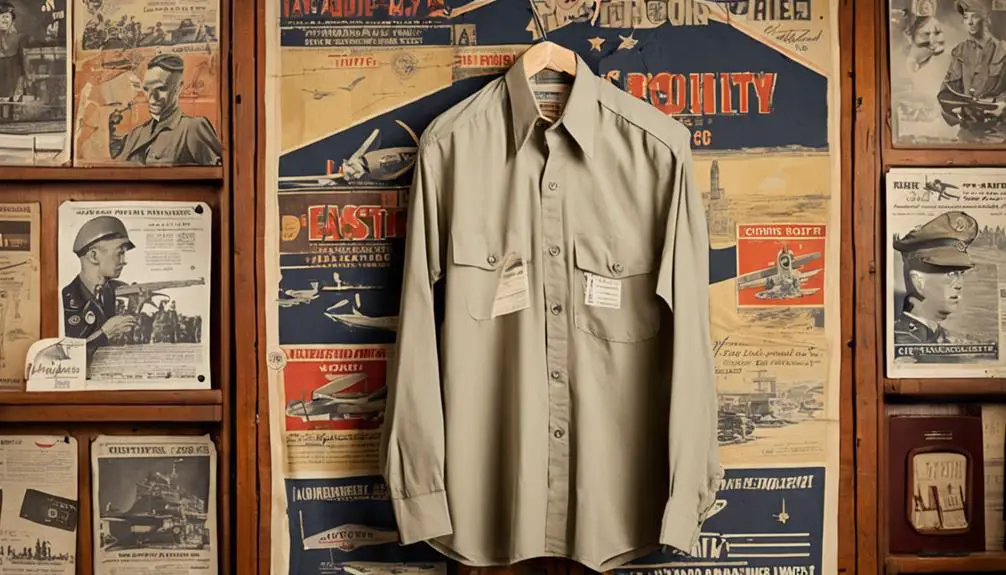
As the 1940s progressed, the impact of World War II reshaped not only everyday life but also men's fashion. Fabric rationing and material shortages forced a pivot towards utilitarian designs in menswear. You'd notice a marked shift from aristocratic influences to practical attire, as new laws restricted clothing purchases. This was a time when every piece of clothing mattered, emphasizing the need to make do with existing garments.
The war also sparked a newfound sense of freedom and patriotism, encouraging the emergence of casual styles. In the domain of men's dress shirts, you saw a significant alteration, particularly in collar design. Softer collars gained popularity, moving away from the rigid structures of previous decades. Long collar tips, also known as spear points, were trendy at the start of the decade but gradually shortened, reflecting a shift toward a more relaxed look.
Even the collarless dress shirt became a symbol of this era, embodying both comfort and practicality. Ultimately, World War II not only transformed everyday life but also left an indelible mark on men's fashion, setting the stage for future styles.
Frequently Asked Questions
What Shirts Did Men Wear in the 1940s?
In the 1940s, you'd find men wearing shirts with various collar styles, muted colors, and fitted designs. Fabrics like cotton and wool gabardine provided comfort, reflecting both fashion trends and material availability during that era.
How Did People Dress in the 40S as Male?
In the 40s, you dressed with a mix of formality and practicality. Tailored suits, often accessorized with ties, defined professional looks, while casual styles included knit shirts, reflecting the era's evolving fashion amid wartime constraints.
What Accessories for Men Played an Important Part of Fashion in the 1940s?
In the 1940s, you'd find accessories like pocket squares, cufflinks, and colorful socks essential to elevating your style. Brogued Oxfords and smoking accessories completed your look, blending elegance with practicality amidst the era's constraints.
Did People Wear T-Shirts in the 40s?
Yes, you'd find people wearing T-shirts in the 1940s, especially soldiers. They embraced T-shirts for their comfort, and post-war, civilians adopted them as casual wear, leading to their rise as an iconic fashion staple.
